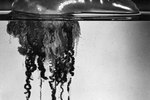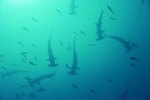
The Venus flytrap sea anemone is a comparatively large anemone whose shape and movement are much like those of a Venus flytrap plant. These sessile, benthic animals can be found in warm waters of the Atlantic Ocean. They're adaptable creatures that, although rare, thrive in environments where conditions are favorable.
Description
The Venus flytrap sea anemone varies greatly in size, from just a few inches tall to a foot tall and almost a foot in diameter. A. aurelia's size depends on age and the available food supply. Like other anemones, the Venus flytrap anemone resembles a flower, but is actually an animal. It consists of a stem-like body topped with a wide mouth-like disk surrounded by tentacles. These anemones vary in color—they often have white or pastel bodies with brightly colored disks and tentacles in shades of pink and orange. They're unusual among anemones because they stand upright and yet are not fully anchored to the substrate. This allows the animals to be swept away rather than buried when the sediment shifts with underwater currents. If threatened, the Venus flytrap anemone can close its disk with the tentacles inside and retract itself so only the stem remains exposed.
Habitat
Found living in depths between 1,500 and 5,000 feet, Actinoscyphia aurelia is one of the lesser-known deep-sea anemone species. These animals have been found and studied in the Atlantic Ocean off the western coast of Africa and in the Gulf of Mexico. Near Africa they have been studied in the Mauretanian region and near Cap Blanc. In these areas A. aurelia is found in high population densities at certain spots on the deep continental shelf. It seems to do especially well in this area at depths of about 3,000 feet. Researchers believe it does well here because the ocean currents are relatively mild. A. aurelia has been found living on rocks, underwater debris, even other sessile invertebrates. In the Gulf of Mexico it has been studied living on the remains of shipwrecks.
Feeding
The Venus flytrap anemone gets its name from its appearance and how it feeds. Actinoscyphia aurelia's disk is able to fold in half, like a tortilla folding into a taco shape, trapping its food inside. The food is then digested in the mouth at the center of the disk. These animals are detritivores: they eat particles of organic matter floating in the water column. When detritus lands on their tentacles or in their open disks, they close to capture the victuals inside. Anemones' bodies are filled with a gel-like substance called mesoglea, which is what allows them to move and change their shape with such elasticity. Deep sea anemones like A. aurelia tend to be detritivores rather than carnivores because of the lack of appropriately sized live prey at these depths.
Life Cycle
Venus flytrap sea anemones are successful reproducers. They reproduce when the males release sperm into the water and the females release eggs. The fertilized eggs remain on the substrate until they hatch. The eggs hatch into pelagic larvae, or planula, which swim in the water column in the mid-ocean range. After feeding and developing, the planula eventually settle on the substrate in a hospitable environment, where plenty of food and few predators are present. After settling, the larvae develop into polyps, or juvenile anemones. Found in large numbers in certain habitats, Actinoscyphia aurelia is considered capable of reproducing rapidly when conditions are favorable. Venus flytrap anemones may be capable of asexual reproduction as some other anemone species are, although this behavior has not been documented.
References
- National Oceanic and Atmospheric Administration: Ocean Explorer—Venus Flytrap Sea Anemone
- Oceanologica Acta: Ecological Observations on the Deep-Sea Anemone Actinoscyphia aurelia [PDF]
- In Deeper Waters: Photographic Studies of Hawaiian Deep-Sea Habitats and Life-Forms: E. H. Chave and Alexander Malahoff
- A Study of Living History: Deep WWII Shipwrecks in the Gulf of Mexico: N. Morris, et al.
- Encyclopedia of Life: Actiniaria
- Encyclopedia Britannica: Sea Anemone
Resources
Photo Credits
-
John Foxx/Stockbyte/Getty Images
Writer Bio
Madeline Masters works as a dog walker and professional writer. In the past she has worked as a fitness columnist, fundraising copywriter and news reporter. Masters won two Pennsylvania Newspaper Association Awards in 2009. She graduated from Elizabethtown College with a Bachelor of Arts in English.



